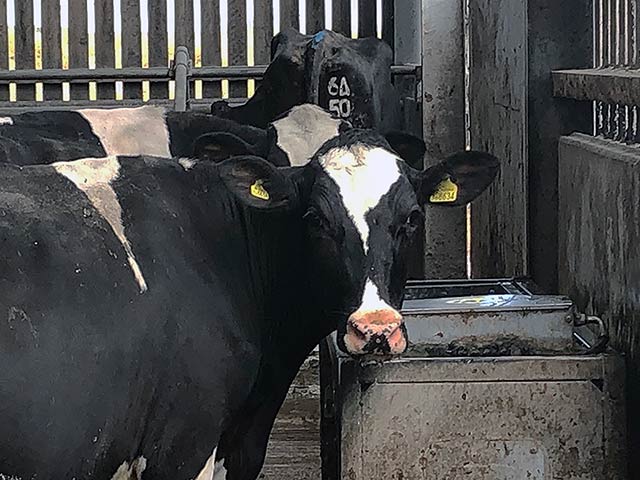
- Water is the most fundamental nutrient in any diet and yet it tends to be the most neglected of the elements of dietary construction.
- We all know that without water we would die, and we all know that thirst is a very strong instinct that lets us know that it is time to top up our fluid levels. Exactly the same is true of the ruminant.
- Ruminants have a huge capacity for water compared to humans, this is because the rumen is necessarily a wet environment, necessary for the rumen micro-flora to flourish and consequently to allow the fermentation process to take place.
- The animal can obtain its water from three sources: –
- Water that is present in food.
- Water that is drunk. There should always be free and easy access to fresh clean water for all ruminants. The distance from water supplies has been estimated at no more than 200 meters for dairy cows. Different references vary, but this is a reasonable guideline, some sources put a maximum of 400 meters for grazing stock, citing that if it is more than this animals will drink less and that there is a consequential reduction in milk yield.
- Because dairy cows are sociable animals, it is important that there is adequate troughspace to allow at least 10% of the herd to drink at any one time. A minimum of 10cm/cow available drinking trough space is advised. Water troughs should be placed in areas that allow free access and not in a dead end.
- Trough height should be 850mm from the floor and water 75mm below the edge for dairy cows.
- Sheep should have access to good clean water when grazed,
When housed it is recommended that they have 30cm to 45cm per ewe at a 5% flock access rate (i e: – 1 in 20.)
Trough height should be 600mm above floor level.
- Water that is released from the metabolism of fat, carbohydrate, and protein. The nutrition models mostly ignore the requirement for the water released by metabolism. Water intakes are directly linked to body weight, dry matter intake, stage of lactation, stage of pregnancy, the number of embryos being carried, environmental factors, and the salt content of the diet.
- Body weight is the main factor which determines dry matter intake. Equally, it is the main factor which determines water intake of non-lactating animals.
- Dry matter intake is the measure from which water requirements are expressed.
(See table 8 below.) - The stage of lactation and milk yield of the female animal is also a major influence on water requirements since about 19% of the ewe’s milk, and 13% of the cow’s milk are solids, and the rest is water.
- Pregnancy requirements for water understandably increase, nearer to calving or lambing, and as the number of calves or lambs increase.
- Individual animals will vary their intakes enormously from the average. The daily fluctuation of individuals is also very significant.
- Environmental factors include temperature, rainfall, and relative humidity.
Hot weather induces heat stress which has some obvious symptoms including panting, reduced intakes and hence milk yield. - There are also some major unseen symptoms, we now know that the tight cell junctions in the gut lining can relax leaving the animal more prone to infectious diseases.
The initial response of the animal under these conditions is increased water loss and increased water consumption. (See table 8 below) . - High rainfall frequently negates the animals need to top up from drinking troughs.
Hot and humid conditions may lower both feed and water intakes together. - Salt is one of the major mineral elements and whilst dietary requirements are relatively small, sometimes the addition of salt to a TMR or a free access salt lick may increase overall palatability and dry matter intake of a diet.
- Sugar, (see molasses) and acetic acid will also improve palatability of the TMR diet and also affect an increase in water intake when the TMR is drier than about 38% dry matter.
- Water temperature should be allowed to adjust to ambient temperature. In normal ambient conditions of 4° C to 20° C water at ambient temperature will be drunk more readily than cold water.
Above 20° C air temperature, water intakes will increase but if the water itself becomes warmer than 20° C there is some evidence that the ruminant will start to drink less! - Although the ARC does not state a particular minimum temperature, they do state that the water should not be frozen! As a guideline a minimum of 4° C is probably a more practical guideline.
- Restricting access to water for more than 12 hours will reduce milk yield. Most cows will drink 2 to 5 times daily, there is no reason to believe that sheep are any different.
In some beef systems withdrawal of water for 24 hours prior to marketing may result in a visual tightening of the gut, whilst this is probably not a particularly healthy tactic, it does seem to have a fairly positive effect on the market price of the animal; it also firms up the faecal output. - pH is an important factor. Generally, it is very rare that the tolerance of pH 6 to 9 is breached.
- Cattle and sheep should avoid drinking water containing toxins, including those emitted by Blue Green Algae.
Water analysis has shown that it can be a source of water-soluble minerals. Most of the time this is of little significance but sometimes there can be high background mineral loading. The most common mineral found in water is Iron, In extreme loading the filters will clog up with Iron Oxide (ochre or rust). Bore hole water is always worth testing and ought to be accounted for in any mineral calculation in the diet, though most of the time it will not result in major changes to mineral supplementation.
Table 8 Water Allowances for Cattle, Sheep and Cows
| Kg water/Kg DM Intake | |||
| Environmental temperature (degrees C) | |||
| <16 | 16 – 20 | >20 | |
| Cattle | |||
| Calves to 6 weeks | 7.0 | 8.0 | 9.0 |
| Cattle, growing, adult. | 5.4 | 6.1 | 7.0 |
| Sheep | |||
| Lambs to 4 weeks | 4.0 | 5.0 | 6.0 |
| Growing or adult sheep | 2.0 | 2.5 | 3.0 |
| Ewes mid pregnancy (twins) | 3.3 | 4.1 | 4.9 |
| Ewes late pregnancy (twins) | 4.4 | 5.5 | 6.6 |
| Ewes lactating 0 to 4 weeks | 4.0 | 5.0 | 6.0 |
| Ewes lactating 4 to 12 weeks | 3.0 | 3.7 | 4.5 |
| Dairy Cows (600 Kg) | |||
| Milk Yield per Day (litres) | |||
| 10 | 81 | 92 | 105 |
| 20 | 92 | 104 | 119 |
| 30 | 103 | 116 | 133 |
| 40 | 113 | 128 | 147 |
These figures are book values and in reality, will be affected by all of the factors outlined above. They are, however, a reasonable guide and starting point for any calculations that farmers may need to make when assessing how much water to supply.
The effect that water intake has on dairy milk yield is profound.
